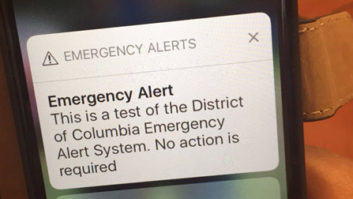Normally a transmitter site or studio facility is a little island in which all the wiring and cabling remains. But what about the occasions in which you have wiring that needs to extend outside of that boundary, but just barely?
For example: you have a generator outside of your studio. You want to measure battery voltage and block heater current; but 50 yards of asphalt and concrete separate the generator from the building. No one is going to pretend that you’ll dig up the lot to put in a conduit for that (and no one had the foresight to do it during installation), and you can’t pull the signaling cable through existing conduits. What now?
Here’s another example: You have an ATU located 200 yards from your AM transmitter building, and you want relay status to come back in to the building. Unfortunately, the original cabling did not include enough conductors; some of the status comes back, just not all of it. Again, no one is going to install a conduit, least of all through a ground system, just for those extra status signals.
One final example: you have a diesel fuel tank at the transmitter site. When the power goes out, after few hours, you find yourself wondering: how much fuel is really left?
WHAT DO YOU DO?

There are ways, of course, to “send” status signals and analog signals across short distances.
One possibility comes from the industrial world — thinking outside the “broadcasting box!”
A good example of that is B&B Electonics. Their Zlinx Xtreme Wireless I/O is a radio modem (900 MHz or 2.4 GHz ISM band) that is intended for outdoor use (rated IP67). In its peer-to-peer mode, you can pass two analog signals, two status signals, and two relay outputs between two of the devices. Range is listed as being as high as 1.5 miles with the antennas provided — so a couple of hundred yards should be easy enough.
“What about security?” you say. Well, they use spread-spectrum and come with either 128 or 256-bit AES encryption. (AES in this context means Advanced Encryption Standard.)
Another version of the same radio (the Industrial Radio Modem) is designed to pass RS-232, 422 or 485 across similar distances at data rates up to 230.4 kbps.
In this application, you could use (as one example) an SRC-16 Plus from Broadcast Tools. This device provides 16 optically-isolated inputs and 16 SPDT, 1-amp relays; two devices will “talk” to one another over a serial data link, such as that provided by the Industrial Radio Modem mentioned earlier.
Broadcast Tools describes it as a “relay extension cord” and thus it fits the theme of this article. The SRC-16 Plus has LED indicators to display input and relay status and three front-panel LEDs that display power, serial transmit and receive data. Connections are made via plug-in euroblock screw terminals. The SRC-16 Plus is supplied with LED indicators to display input and relay status. Three front panel LEDs display power, serial transmit and receive data. Plug-in euroblock screw terminals are provided for ease of wire installation/removal.

I’ll admit that the remote generator fuel tank monitoring scheme is a bit more tough, but here’s the idea: Use an ultrasonic depth gauge that indicates depth via an analog signal. Then, send that data over a radio modem like the Wireless I/O (mentioned above).
As one example: BinMaster makes the SmartSonic line of ultrasonic, narrow beam technology distance sensors. “SmartSonic”s sensor probes are designed to adapt to the internal tank conditions, automatically adjusting power and receiver sensitivity to any distance and reflecting surface. This technology ensures the same echo is maintained over the entire operating range which enhances measurement accuracy,” according to their brochure (the URL of which is seen below). The sensor is programmed to send out a 4-20 mA analog signal (which is compatible with the wireless I/O modem mentioned earlier), or it can send out its data via RS232 or 485, to a computer running the company’s calibration/data logging software.
In this application, you’d use the Industrial Radio Modem.
Irwin is RF engineer/project manager for Clear Channel Los Angeles. Contact him at [email protected].












